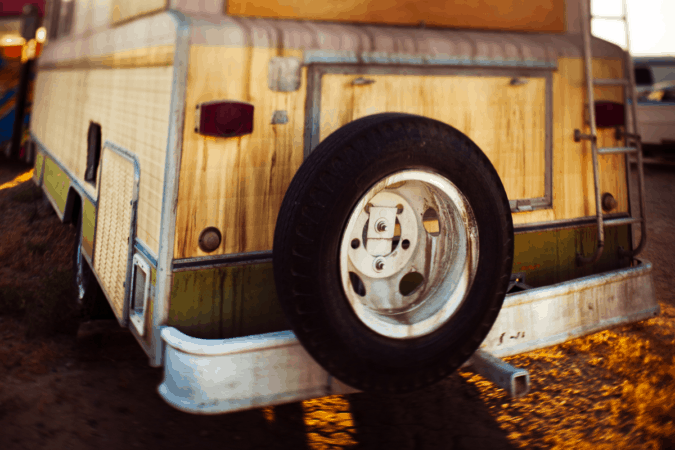How do you remove oxidation from RV fiberglass? We tell you how!
Most RV exteriors are made out of fiberglass, or fiber reinforced plastic with a gel coat finish. These materials are lightweight, dependable and durable; this is very important for a vehicle designed to travel long distances. Gel coat is a synthetic resin-based product used to coat and protect the fiberglass. Fiberglass gel coat is less than 1/32” thick, and it’s bonded directly to the fiberglass surface. The gel coat is what gives your RV it’s brilliant shine. However, over time, that shine will become dull, making your RV look old and junky.

Why Does an RV Gel Coat Lose Its Shine?
Over time, the gel coat on your RV becomes cloudy, chalky and even yellowed. This is due to the natural process of oxidation. Oxidation is a chemical reaction with the oxygen in the air. Rust on iron is an example of oxidation. Fruit turning brown is also oxidation. The same type of thing will eventually happen to the gel coat on your RV, especially if your RV is exposed to the elements. The sun is especially hard on the gel coat of your RV.
How to Make Your RV Gel Coat Shine Again
As an RV owner, you should be aware that maintaining your RV finish may get neglected. Washing and waxing an RV is a big job. However, if you want to keep your RV looking good and maintain it’s resale value, keeping the shine is essential. The best way to make your RV look shiny and new again, begins with removing any oxidation on the exterior surface. That process should be followed with a few coats of wax specifically made for fiberglass gel coats.
Your RV should be washed once a month with a car wash, then waxed. The wax will form a protective coating between the elements and the gel coat. But after a period of time, the wax will wear off and the gel coat will be exposed once again to the elements. As a result, this requires the regular removal of oxidation and a fresh coat of wax.
First, Know What Kind of RV You’re Trying to Restore
Not all RVs are made the same; RVs are manufactured in a wide variety of exterior materials and finishes. The following list will help you when deciding which is the best RV oxidation removal products, polishes and waxes to restore your RV.
#1 – Fiberglass Gel Coat
- This is the most common type of RV exterior. Fiberglass with gel coat encompasses the most moderately priced motorhomes and trailers, to the high end motorhomes
- A fiberglass gel coat RV will likely be white or cream colored
- These RVs usually have decals, striping and lettering
- A fiberglass gel coat RV may also have some paint, such as at the bottom of the body, or the stripes
- Fiberglass gel coat will become blotchy, hazy and chalky looking over time
#2 – Corrugated Fiberglass or Aluminum
- Corrugated RVs can actually be a textured corrugation or smooth-sided
- These are the least expensive travel trailers and toy haulers
- Corrugated fiberglass or aluminum RVs are usually white but could be painted any color
- These toy haulers and travel trailers usually have a lot of vinyl decals and lettering
#3 – Fully Painted Finish
- These RVs have a full two-stage paint job, just like a car. This includes a color paint coat with a clear topcoat
- Fully painted RVs are the most expensive, most commonly the high-end Class A motorhomes. They are the least common type of RV
- Fully painted motorhomes are the easiest to wash and wax. They can be washed and waxed the same as a car
#4 – Bare and Coated Aluminum Finish
- This is rare, and only represented by Airstream trailers today
Older aluminum trailers are made of bare aluminum. These can be polished. However, all newer Airstreams have a clear coat over the aluminum. These need to be maintained like car paint.
Advice for Removing Oxidation from RV Fiberglass
Polishes containing mild abrasives are a good option for removing oxidation from RV fiberglass. These will also remove light scratches, surface stains and weathered paint. Keep in mind, polishes are not a protective finish, and need to be topped off with wax. However, waxes and polishes only work for fiberglass RV exteriors with little to moderate oxidation.
Remove Oxidation from RV Fiberglass with Hand Buffing
- To restore oxidized RV fiberglass, you simply need a little elbow grease and some polishing compound.
- Apply the polishing product with an ordinary non-scratch kitchen scrubby sponge.
- Work the polish into the surface by hand, and polish until you don’t feel any more resistance.
- Allow the polish to dry and haze over.
- Finally, wipe off the haze with a clean, dry cloth, to reveal the shiny surface underneath.
- Top it off with a quality marine or RV grade wax. Apply the wax with a clean dry cloth, allow the wax to dry to a haze, then polish off to a shiny finish.
Removing RV Oxidation with a Power Buffer
Using an electric power buffer will not only save you time, but it will also be less stressful and exert less strain on your body. Use the electric power buffer, with polish, to remove oxidation from large areas of your RV. Likewise, use a kitchen scrubby sponge and polish to remove oxidation from the little nooks and crannies on your rig.
The power buffer can be used to apply the polish, and remove the oxidation from your RV gel coat. However, it can also be used to apply the wax, and buff your RV to a brilliant shine. Use a wax designed to protect the fiberglass surface of an RV. Marine wax, formulated for boats, can also be used.
Restoring Extreme Fiberglass Oxidation
As the fiberglass on an RV ages, it can be subject to damage that even professional products can’t fix. In this case, a wet sanding is used to address the damage. This is time consuming, and requires attention to all the small details. Soak sand paper with 600 ranging to 2,000 grits for 24 hours. Next, place the sand paper on a foam block. Sand until the fiberglass surface is smooth to the touch. Follow the sanding with a high grade, super duty polish. You may need multiple applications for the desired effect.
In extreme oxidation, you may see strands of fibers coming to the surface. If this is the case with your RV, use a pair of tweezers to see if you can pull the fibers apart from the surface. If this happens, your RV fiberglass has erosion. If this is the case, you have two choices; the first choice is to have a professional RV paint job. The second choice is to get the fiberglass surface gel coated again. Both painting and gel coating take about the same amount of time and money. However, gel coat will last longer, and has better overall results.
If you can’t pull the fibers away from the surface with a pair of tweezers, it’s called imprinting. The solution to this irregularity is to use wet and dry sand paper, with a padded sanding block. Once the irregularity is leveled out, follow it up with either paint, or a new gel coat layer.
RV Washing Tips to Prevent RV Oxidation
Wash your fiberglass RV monthly to help prevent the buildup of oxidation. An RV “wash and wax” product is a good choice. This will make the job easier, and keep dirt and grime, as well as oxidation from building up.
It is also a good idea to wax your RV at least once a year to maintain it’s shine and provide protection to the finish. If you have a used RV that shows signs of considerable oxidation, use a fiberglass restorer in addition to washing and waxing it.
RV Fiberglass Maintenance
Environmental extremes like the intense desert sun, air pollution, extreme humidity, and parking under a tree can cause damage to the surface of your motorhome or travel trailer. If you are concerned about the finish of your RV, keep it out of the sun when you’re not using it. It’s preferable to keep it in a garage if possible, or under an RV cover. This prevents the damaging UV rays from oxidizing the gel coat.
Additional Questions About Removing Oxidation from RV Fiberglass
#1 – Do I Really Need to Wax My RV?
Yes you do. If your RV is fully painted or coated aluminum, use a good quality car wax. If your RV has a fiberglass body and gel coated, use a wax designed for gel coated fiberglass. Additionally, there are 2 in 1 RV wax products, that have both a mild polish and wax in the same bottle. These are appropriate for lightly oxidized surfaces.
#2 – Do I Really Need to Use a Marine Grade or RV Grade Wax?
Yes you should. Both RVs and boats are manufactured primarily from fiberglass and gel coated. So yes, these are the appropriate products for your trailer or motorhome.
#3 – What Type of Electric Power Buffer Should I Use on a Fiberglass Gel Coat RV?
A high speed, random orbital buffer can be used when waxing an RV. Fiberglass gel coat is a tough material, and needs high speeds and a lot of friction to get a good result.




